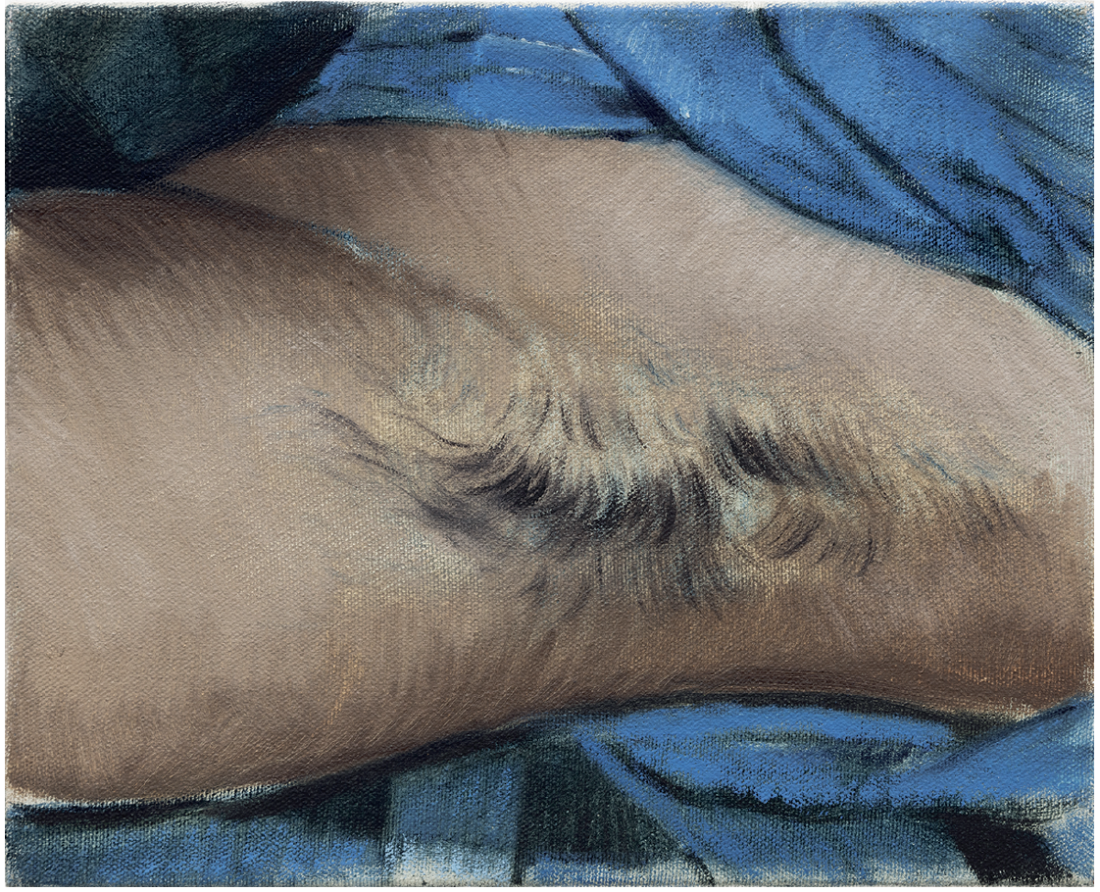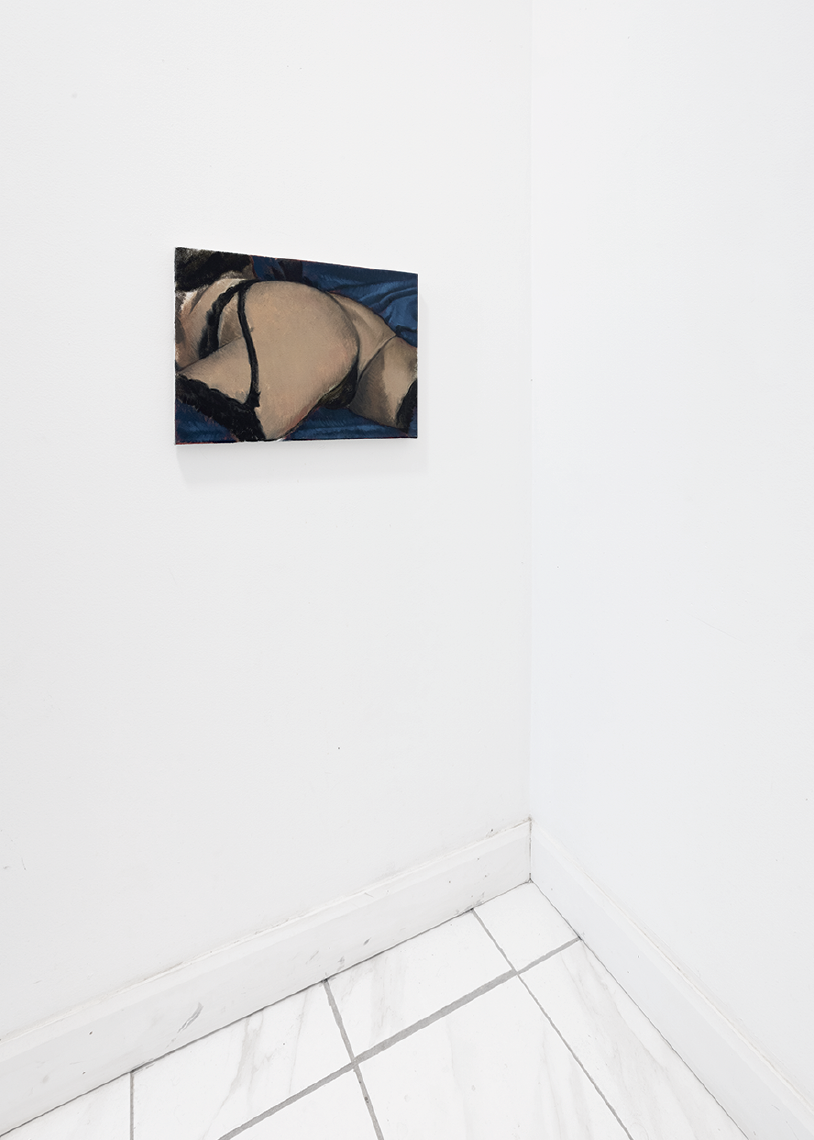Marni Marriott
There’s a small painting on my left in Marni Marriott’s exhibition at Hunt Gallery: an armpit with tender wisps of hair ensconced in a blue veil. It’s titled My Destiny, 2024. The whiteness of the flesh and the chalky blue of the folded cloth are the same as in Ingres’s little 19th-century jewel The Virgin Adoring the Host. The painting is cropped closely, excluding everything but this armpit. The painter’s attention to this armpit—the way her brush strokes radiate in towards the hollowed pit—makes me wonder if armpit fetishism is a thing (I look it up in the gallery and it is). I think about the woman who washed and cut my hair when I was a kid, whose tender, powdery white armpit I used to stare into while my head was massaged in the sink. This is how Marni Marriott’s paintings unfolded for me: from picture to picture, art history, cultural references and memories piled up.
In this recent solo exhibition, the artist showed paintings that were sexy, dark, funny and dense with reference. Marriott paints from collected pictures (screenshots of YouTube videos, films, porn and ads) as well as photographs she takes herself. Her treatment creates a coherence; the origin of any given image isn’t clear. Pictures congeal on the canvas out of hatching strokes in Marriott’s muted, wet cardboard palette. They look lo-fi somehow. Her 12 paintings (all of which are close-ups) could be scenes from a single Baroque-ish, queer, soft core, paranormal, art house film shot on a 2004 Sony Handycam.

Marni Marriott, My Destiny, 2024, oil on canvas, 22.86 × 27.94 × 1.27 centimetres. Photo: LF Documentation. Courtesy Hunt Gallery, Toronto.
I messaged Marriott about the show—I liked her work so much I wanted to talk about it. I asked her about ideas of becoming something or someone else and how her subjects flicker in a symbolic limbo. In response Marriott talked about images that marry the theatrical and erotic qualities implicit in her experience of her sexuality and gender, and she talked about a Rubens painting of sphinx statues with “ridiculously perfect-looking boobs.” She recalls that she thought, while looking at the sphinxes, why is this half-woman/half-beast so relatable?
Nearly all of Marriott’s paintings play with ideas of becoming, but two paintings deal directly with hybrid figures: the vampire and the werewolf. In Kitchen Scene, 2024, a figure’s head is bent backwards, revealing the peaks and valleys of a shoulder, neck and jaw. Two puncture wounds shimmer red. In Moon and Symbols, 2024, a figure removes their blue drawstring pants to reveal red panties, and faces a full moon shining from behind a veil of clouds. Using monsters as a metaphor for the abject body—in this case the queer body and the female body—isn’t new and Marriott uses it sparingly, allowing for these two paintings to be playful keys among their more ambiguous counterparts. Actress, 2024, is one of these more enigmatic paintings. A figure in profile with downcast eyes and teased platinum blonde hair is described by Marriott as a screenshot from a Sissification porno where a group of women shave and put makeup on a man. It’s a joke, she explained in an interview with Hunt’s director, Daniel Hunt, “[I’m] rejecting this idea that my work has to speak about this sanitized and academic experience of my transness.”
Marriott’s show is peppered with jokes. I walk around the rectangular gallery. Eleven paintings hang in the main space. Daniel pokes his head out from the office and tells me there’s one in the bathroom. I walk down the hallway to see this last painting. Bussy Discourse, 2024, a painting of an ass in black gartered stockings, is hung at eye level for anyone sitting on the toilet. It’s like a better, gayer, L’Origine du Monde.

Marni Marriott, installation view, “Fugue State,” 2024, Hunt Gallery, Toronto. Photo: LF Documentation. Courtesy Hunt Gallery, Toronto. Artwork: Bussy Discourse, 2024, oil on canvas, 30.48 × 40.64 × 1.27 centimetres.
A lot of painters use references and they appropriate pictures (myself included), and it makes sense. We see more pictures today than we ever have. Many of these images evaporate from memory after passing under our scrolling thumbs, but sometimes, a picture gets stuck and wedges itself into our psyches and then these pictures accumulate. I recognized the reference for Chess Pieces with Symbols, 2024, immediately. A painting of two pawns that distinctly resemble breasts, pinched between a pair of thumbs and forefingers, it’s from Austin Powers, The Spy Who Shagged Me. I watched the Austin Powers trilogy a lot one summer when I was 11 or 12. We used to pretend that we were the fembots—sex robots whose formidable breasts had Inspector Gadget-ish swappable nipples that could spray sleeping gas or shoot bullets. We thought they were excellent. The campy sexiness of this movie remains with me and has affected how I think about sex and femininity: goofy, fun, raunchy, pastiche. I wonder if Marriott had the same experience.
The paintings in “Fugue State” are open-ended. They leave a lot of room for interpretation, they’re symbolically dense and their titles aren’t helpful in their decoding. They’re personal and vulnerable and funny. I’ve read only one text that acknowledges the weight of a good joke and it’s Freud’s text on humour. He wrote about jokes using the same methodology he used to analyze dreams: the joke is a vehicle for the subconscious to process one’s life and all the intricacies involved in that life. And I think good paintings do the same thing. Marriott’s paintings certainly do. ❚
“Fugue State” was exhibited at Hunt Gallery, Toronto, from July 12, 2024, to August 10, 2024.
Sophia Lapres is an artist who lives in Toronto.

